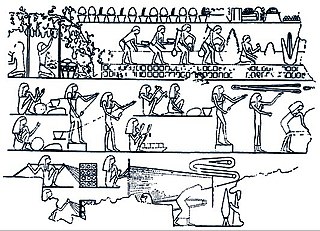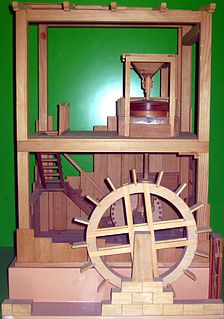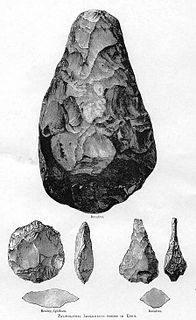 W
WAncient Egyptian technology describes devices and technologies invented or used in Ancient Egypt. The Egyptians invented and used many simple machines, such as the ramp and the lever, to aid construction processes. They used rope trusses to stiffen the beam of ships. Egyptian paper, made from papyrus, and pottery were mass-produced and exported throughout the Mediterranean Basin. The wheel was used for a number of purposes, but chariots only came into use after the Second Intermediate Period. The Egyptians also played an important role in developing Mediterranean maritime technology including ships and lighthouses.
 W
WAncient Greek technology developed during the 5th century BC, continuing up to and including the Roman period, and beyond. Inventions that are credited to the ancient Greeks include the gear, screw, rotary mills, bronze casting techniques, water clock, water organ, torsion catapult, the use of steam to operate some experimental machines and toys, and a chart to find prime numbers. Many of these inventions occurred late in the Greek period, often inspired by the need to improve weapons and tactics in war. However, peaceful uses are shown by their early development of the watermill, a device which pointed to further exploitation on a large scale under the Romans. They developed surveying and mathematics to an advanced state, and many of their technical advances were published by philosophers, like Archimedes and Heron.
 W
WMedieval technology is the technology used in medieval Europe under Christian rule. After the Renaissance of the 12th century, medieval Europe saw a radical change in the rate of new inventions, innovations in the ways of managing traditional means of production, and economic growth. The period saw major technological advances, including the adoption of gunpowder, the invention of vertical windmills, spectacles, mechanical clocks, and greatly improved water mills, building techniques, and agriculture in general.
 W
WThe Copper Age, also called the Eneolithic or the Chalcolithic Age, has been traditionally understood as a transitional period between the Neolithic and the Bronze Age, in which a gradual introduction of the metal took place, while stone was still the main resource utilized. Recent archaeology has found that the metal was not introduced so gradually and that this entailed significant social changes, such as developments in the type of habitation, long-distance trade, and copper metallurgy.
 W
WThe following outline is provided as an overview of and topical guide to prehistoric technology.
 W
WRenaissance technology was the set of European artifacts and inventions which spread through the Renaissance period, roughly the 14th century through the 16th century. The era is marked by profound technical advancements such as the printing press, linear perspective in drawing, patent law, double shell domes and bastion fortresses. Sketchbooks from artisans of the period give a deep insight into the mechanical technology then known and applied.
 W
WThe ancient Egyptians were one of the first cultures to widely divide days into generally agreed-upon equal parts, using early timekeeping devices such as sundials, shadow clocks, and merkhets . Obelisks are used by reading the shadow that it makes. The citizens could divide the day into two parts, and then into smaller hours.